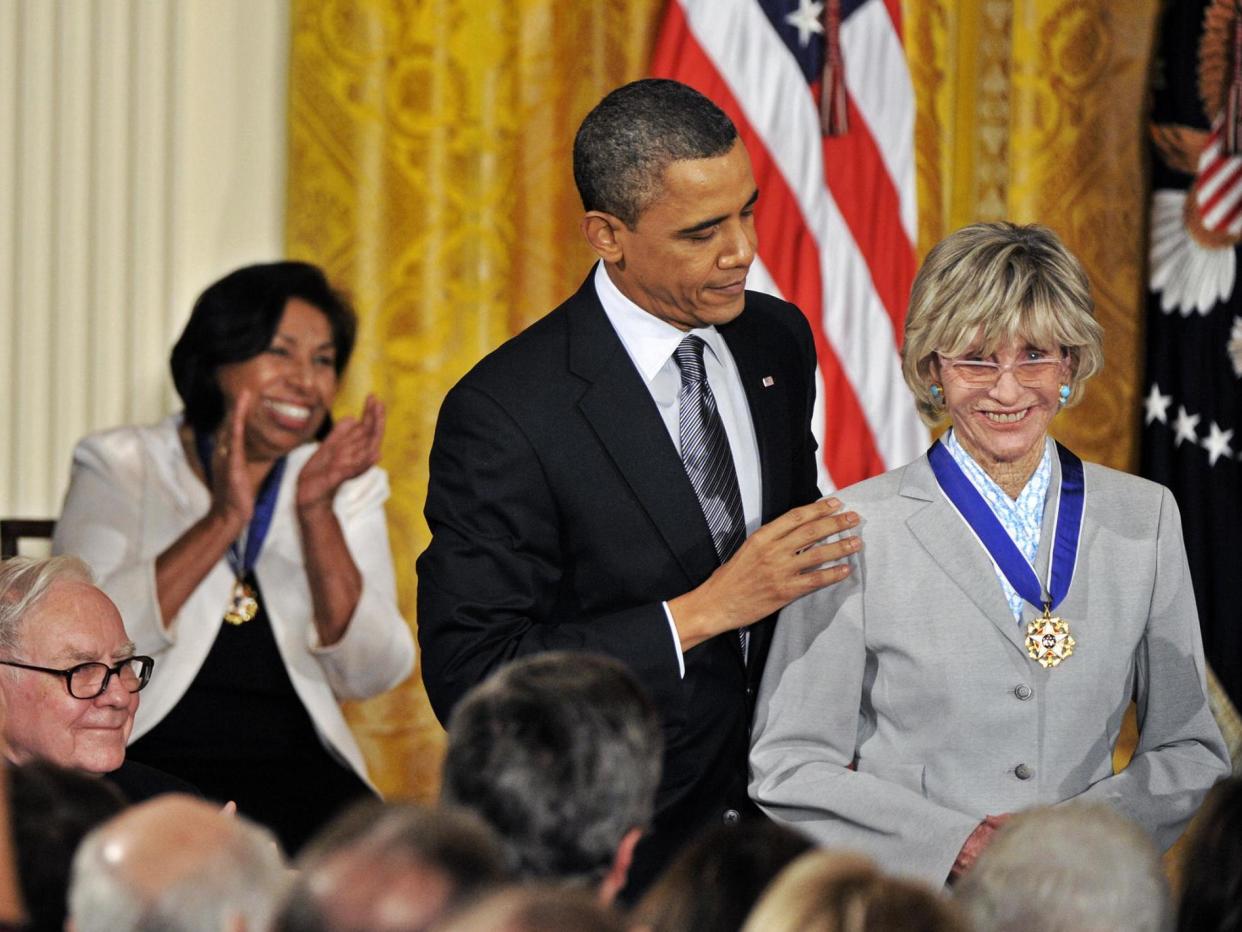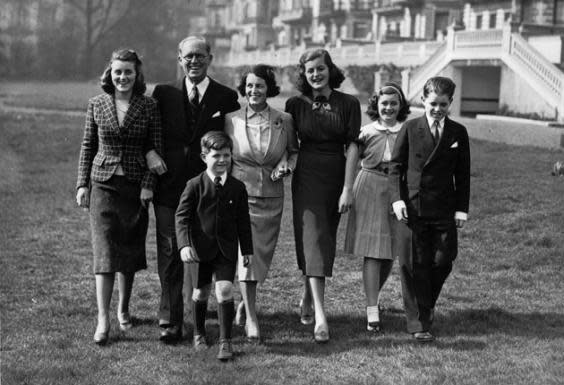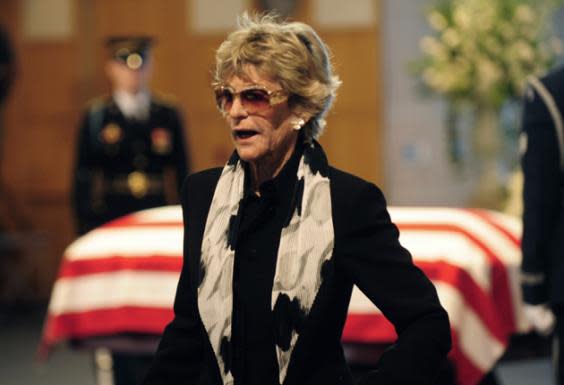Jean Kennedy Smith: US ambassador and architect of peace in Northern Ireland

Jean Kennedy Smith was a former US ambassador to Ireland and the last of a generation of overachieving, tragedy-stalked siblings whose influence on American political life and culture probably surpassed that of any other single family. She died on 17 June at her home in Manhattan. She was 92.
Her daughter Amanda Hood confirmed the death but said she did not know the cause.
Smith was often described as the quiet Kennedy. She kept a lower profile than her kin, but it was hard not to when her siblings included President John F Kennedy; senators Edward and Robert Kennedy, both of whom ran for president themselves; a sister, Patricia, who wed and later divorced movie actor Peter Lawford; Joseph, a naval aviator killed in the Second World War; and Eunice, the founder of the Special Olympics.
Jean Kennedy Smith achieved political renown in her own right as one of the architects of peace in Northern Ireland and as a Presidential Medal of Freedom recipient for her work with children with intellectual and physical disabilities. Historian Arthur Schlesinger Jr once said of her work as ambassador from 1993 to 1998, “Jean may well be the best politician of all the Kennedys, but she needed this position to really show that.”
But it will be her contribution to the larger legacy and legend of the Kennedy clan, often considered America’s answer to a royal family, that will forever mark her place in history.
“I was part of the tide,” she once said to the Boston Globe. “I really didn’t think of it as a Kennedy thing. I thought of it as a moment. A moment in history.”
Smith’s illustrious siblings seemed to carry a curse. Two of them were assassinated, two died in tragic plane accidents, one brought the family permanent shame by leaving a woman to die in the waters of Chappaquiddick, Massachusetts, and one was left in a vegetative state for life after her father ordered up a controversial lobotomy.
Spouses and children endured more than their fair share of scandals and tragedies as well, and Smith wasn’t immune. Her son William Kennedy Smith dragged the family into the tabloids in 1991, when he was accused of raping a woman at a Kennedy compound in Palm Beach, Florida. He was later acquitted, and in 2014 won his first political office, a seat on the Foggy Bottom advisory neighbourhood commission in Washington.
Rose Kennedy, the family matriarch, famously said of her youngest daughter, “She was born so late that she only was able to enjoy the tragedies, and not the triumphs.” But Smith never saw it that way. She lived her 80-plus years in dedication to the larger cause of the family, embodying the principle she believed her family stood for, “that you can believe in something bigger than yourself”.
Even out of their tragedies, Smith and her siblings alchemised lasting political impact. Sister Rosemary’s intellectual disabilities led directly to Smith’s establishment of Very Special Arts, and Eunice’s creation of the Special Olympics, two organisations that expanded the opportunities for those with disabilities. Very Special Arts, working closely with the Kennedy Centre, now provides artistic outlets for disabled children and adults in 55 countries.
She once told The Irish Times she resented being described at times as a dilettante. “They said I did charity work, but if I were a man, they would have said I ran an international organisation.”
Jean Ann Kennedy was born in Boston on 20 February 1928, and was the eighth child of Joseph Kennedy Sr and the former Rose Fitzgerald.
Seventeen years separated eldest sibling from youngest. The very youngest three – Jean, Edward and Robert – ate at a separate children’s table and lived forever in the shadow of the “golden trio” of eldest children, Joe Jr, John and Kathleen.
That secondary status was not altogether unwelcome by the younger siblings. The blowtorch Joe Sr aimed at his family to spur achievement was somewhat deflected by the eldest children, allowing the younger ones such as Jean to fly a little lower under the radar, and better chart their own courses.
Edward was probably Jean’s closest sibling. “They were a pair,” Rose Kennedy wrote in her autobiography. “They trotted around together; she sometimes admonished him and sometimes scrapped with him, but mainly was his valiant friend and big sister.” It was Edward who later secured Jean the ambassador’s job during the Clinton administration.
“Tragedies were visited much earlier on Jean and Teddy than they were on the older kids,” historian Doris Kearns Goodwin noted in her 1987 book The Fitzgeralds and the Kennedys.
Jean was 13 when her sister Rosemary was sent away to an institution, 16 when her brother Joe was killed in the Second World War and 19 when her sister Kathleen died in a plane crash.
Early on, Jean began to play a key role in the family, as matchmaker for three of her siblings. While attending Manhattanville College of the Sacred Heart in Manhattan (later Manhattanville College in Purchase, New York), she became friends with Ethel Skakel, who married Robert in 1950, and Joan Bennett, who married Edward in 1958.
The day Jacqueline Bouvier stopped at the Kennedys’ compound in Hyannis Port, Massachusetts, to pick Jean up for a riding outing was the day she met her future husband, John.

Jean graduated from Manhattanville in 1949 and six years later married her beau, Stephen Smith, a transportation executive who put his own political ambitions aside to serve the Kennedy family. Jean and Stephen built their home in Hyannis Port to be near the centre of gravity and they raised their children.
Stephen Smith died in 1990. In addition to her daughter Amanda, of Washington, survivors include three other children, Stephen Smith Jr, William Kennedy Smith, and Kym Smith; and seven grandchildren.
Stephen Smith helped organise John and Robert’s presidential runs in the 1960s, and he managed Edward’s campaign when he ran for president in 1980. He also managed the entire Kennedy financial estate for a number of years.
The sisters were just as integral as the brothers in Kennedy’s victories. Jean, Eunice and Patricia coordinated the volunteers who hosted house parties in early races, bringing the campaign directly to voters in their neighbourhoods.
During John’s presidency, Jean and Eunice travelled with him to Ireland in June 1963 for a triumphant return to the family’s homeland in New Ross, Co Wexford, as the most powerful man in the world. It was a watershed moment for the Irish, many of whom had two photos on their walls side by side, Kennedy and the Pope. But it was also a big moment for John and Jean. She told a Washington Post interviewer it was one of the “brightest days of his life”. And he promised to return.
“I’ll be back in the springtime,” the president said just before he left, but he was shot by Lee Harvey Oswald that November.
President Bill Clinton appointed Smith ambassador on St Patrick’s Day in 1993, hoping to take advantage of the enduring aura of the Kennedy family and break the cycle of violence between Catholics and Protestants in Northern Ireland. She was the first daughter of an ambassador to be appointed as an ambassador.
Exactly 30 years after John’s visit, Jean returned to Ireland’s shores as the US envoy. According to the Boston Globe, she brought her nomination ceremony photo, which was signed by her brother Edward: “For Jean, who is going back in the springtime.”
Smith immediately found she had universal appeal as ambassador, both to the Irish as the sister of the first Irish president of the United States, and to the British, who had been in love with the Kennedy children since Joe Sr was ambassador to the Court of St James in the late 1930s.
The Irish Republican Army, which didn’t trust the British government, turned to the United States to broker the peace process between Northern Ireland and Britain. Smith helped bring leaders such as Gerry Adams, president of Sinn Fein, the IRA’s political wing, and hardline IRA activist Joe Cahill to the table in New York, where talks could be held on neutral ground and carry the imprimatur of the United States.
“She believes in dialogue, in creating the conditions that lead to dialogue,” Adams told the Boston Globe.
Not everyone agreed with Smith’s support of Adams or her willingness to ruffle feathers in Britain with her headlong push for peace.

In an interview in 1998 for an oral history project, Admiral William J Crowe, who was US ambassador to Britain during the peace process, said, “She thought the British should get the hell out of the way and quit blocking progress. Offending the British didn’t bother her in the least.”
The State Department once reprimanded her for removing embassy employees who disagreed with her views on Northern Ireland. “She was not kind to the people that worked for her,” Crowe said. “She was tough to deal with and thought Northern Ireland was her territory.”
But winning Adams’s trust changed the political climate, clearing the way for a cease-fire that laid the groundwork for the Good Friday peace agreement in 1998 that ended the long sectarian war.
As a result, Crowe said, “She’s the best ambassador the Irish people ever have had from the United States. Fortunately, that wasn’t her job, but she never figured that out.”
Much of Smith’s life afterward was dedicated to filling her assassinated brothers’ interrupted promise, focusing on the care of the disenfranchised and disadvantaged.
She collected dozens of citations for her work with the disabled. In 2011, President Obama awarded her the Presidential Medal of Freedom, the nation’s highest civilian honour.
In a video she made for the White House to commemorate the event, she summed up the ethos that bound her famous brothers and sisters.
“My parents felt very strongly, my mother in particular, if you have a happy home, much is given, much is expected,” she said, adding that she viewed the entirety of her adult life as “payback time”.
Jean Kennedy Smith, US ambassador to Ireland, born 20 February 1928, died 17 June 2020
© The Washington Post
Read more
William Sessions: FBI director who battled agency’s old guard

